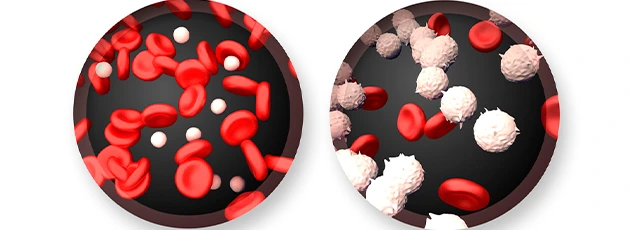Leukemia Treatment in Israel

Leukemia is a malignant hematologic disease. It can be acute or chronic. Leukemia treatment in Israel provides for long-term remission and, sometimes, complete cure.
This is achieved thanks to state-of-the-art chemotherapy followed by stem cell transplantation, as well as targeted therapy and biological treatment.
What To Expect From Leukemia Diagnosis In Top Ichilov
Cost of leukemia diagnosis: $3,842.
Duration of the program: 3-4 days.
- Day 1: Initial consultation. The patient consults with Dr. I. Molchanov, physician of the Cancer Diagnostics Department. The physician performs a physical examination and studies the patient’s health history. Dr. Molchanov refers the patient to the laboratory and instrumental studies that are carried out the next day. If the patient has brought the already-biopsied bone marrow samples, they are sent for revision. Results come within 6-10 days.
- Day 2: Diagnosis. In the morning, the specialists take samples of blood and urine for analyses (functions of vital organs, tumor markers, etc.). This is followed by PET/CT, currently the most precise imaging study indicated for malignant diseases. During all procedures and consultations the patient is accompanied by a medical coordinator-interpreter.
- Day 3. Specialist consultations and treatment planning. The patients receives the results of diagnostic procedures and consults with a hematologist-oncologist – Prof. E. Naparstek or Dr. O. Gur.
Cost of diagnostic tests for leukemia: $3,842.
Comprehensive telemedicine package for leukemia treatment: $590.
✓ Right Now: An opportunity to consult a Top Ichilov physician free of charge
It is important to correctly determine the type of the disease before starting treatment in the country of residence. Consult an Israeli physician right now, free of charge. Find out the prices for the necessary diagnostic procedures in Top Ichilov.
What Are The Benefits Of Leukemia Treatment In Israel?
- More effective chemotherapy. Israeli physicians work with a wider range of chemotherapy agents. This means greater experience and more opportunities for maneuvering when treating a patient.
- Use of biological therapy. Biological medications are the newest type of anti-cancer treatment in Israel. They stimulate the immune system to fight tumor cells. Some biological agents selectively destroy cancer cells.
Doctors Specializing In Leukemia Diagnosis And Treatment In Top Ichilov
Leukemia treatment in Top Ichilov is provided by the leading experts in hematologic oncology:

Professor Ella Naparstek, hematologist-oncologist with 40 years of professional experience. Professor of Hematology Department at the Hebrew University of Jerusalem, author of more than 160 scientific papers. Worked in the leading clinics of Israel and the USA; member of 8 international professional organizations.

Doctor Odelia Gur, hematologist, hematologist-oncologist, professional experience: about 30 years. Head of day inpatient facility in the Oncology-Hematology Department. Member of Hematology Associations in Israel and the USA.
If necessary, treatment is also provided by physicians of related specialties: radiologists, surgeons, etc.
What Leukemia Treatment Methods Are Used In Israel?
Chemotherapy
Chemotherapy is the main method of leukemia treatment.
Treatment may be divided into 2 stages:
- The purpose of Stage 1 is to destroy malignant blood cells and to achieve remission.
- The purpose of Stage 2 is to destroy remaining leukemia cells and to prevent recurrence.

Systemic chemotherapy may be combined with local injections of chemotherapy agents into areas containing cancer cells, for instance, cerebrospinal fluid. This method of administering chemotherapy is called intrathecal. The drugs are administered into the spinal canal through a catheter.
Stem Cell Transplantation
Chemotherapy and radiation therapy for leukemia destroy not only malignant cells but also normal blood cells. This is why some patients receive a stem cell transplant after therapy. Transplanted healthy stem cells later transform into healthy blood cells.
Stem cells may come from different sources:
- autologous transplantation – stem cells are taken from the patient themselves before starting chemotherapy;
- allogeneic transplantation – stem cells are taken from any donor compatible with the patient;
- syngeneic transplantation – stem cells are taken from the patient’s identical twin.
Targeted Therapy
Targeted therapy involves use of medications in order to identify and destroy cancer cells.
Get a free consultation of an Israeli physician
Biological Treatment
During the treatment of some types of leukemia in Israel doctors use drugs that stimulate the patient’s immune system to fight cancer cells. These drugs include, for instance, interferon.
Radiation Therapy
Different types of leukemia may require either systemic radiation therapy (affecting the whole body) or “targeted” irradiation of cancer cell clusters in lymph nodes, spleen, brain, etc.
The Cost Of Leukemia Diagnosis And Treatment In Israel
| Procedure | Price, $ |
|---|---|
| Chemotherapy (1 course) | 1814 |
| Each 1 day of extended hospital stay | 1754 |
| Consultation with hematologist-oncologist | от 644 |
How To Receive Leukemia Treatment In Top Ichilov:
- Call the clinic right now: +972-37621629
- Or fill in the form below. Our doctor will contact you within 2 hours.
What Is Leukemia?
Leukemia is a hematologic cancer that develops in bone marrow – soft, spongy bone tissue. In healthy bone marrow, new blood cells mature and then enter the circulation. In order to comprehend what happens to blood in leukemia, one has to understand what the healthy bone marrow normally does.
How Does the Normal Bone Marrow Function?
Red blood cells – erythrocytes – comprise the bulk of blood. They transport oxygen and carbon dioxide throughout the entire body. The per cent of red blood cells in circulating blood is called the hematocrit. The part of a red blood cell responsible for oxygen transportation is a protein called hemoglobin. In order to function normally, all tissues in the human body need oxygen. When bone marrow works as it should, the number of red blood cells remains stable. A red blood cell deficit leads to anemia. Anemia may develop from either leukemia or chemotherapy used to treat this disease. Symptoms of anemia include breathing difficulties, headache, weakness and fatigue.
White blood cells, or leukocytes, are divided into several types. Each of these types has its own role in the protection against infections:
- Neutrophils (also known as granulocytes or polymorphonuclear leukocytes) kill most germs.
- Monocytes kill various infective agents, including tuberculosis bacteria.
- Lymphocytes destroy viruses, manage the immune system and increase the body’s resistance to infections.
White blood cells play an important role in fighting infections. Infectious diseases develop when there is a shortage of healthy white blood cells in the body.
The absolute neutrophil count (ANC) is a measure of the number of white blood cells able to fight infections. The ANC is calculated by multiplying the overall number of white blood cells by the per cent of neutrophils.
Even though any person can get a common cold or other infectious disease, the risk increases when ACN falls below 500. Within the first week of chemotherapy the number of white blood cells decreases, but within the period from the 21st to 28th day of treatment it is usually restored back to normal.
Thrombocytes are cells that help control bleeding. If you cut yourself, thrombocytes will aggregate in the injured area and form a plug to stop the bleeding.
Bone marrow is a type of soft tissue inside the bones. Blood cells are produced in the bone marrow. All blood cells come from stem cells in the bone marrow.
Bone marrow consists of blood cells at different stages of maturation. When these cells mature, they leave bone marrow and enter the circulation. Blood that circulates throughout the body outside bone marrow is called peripheral blood.
Stem cells are very immature cells. When necessary, they develop into mature red blood cells, white blood cells or thrombocytes.
What Happens In Leukemia?
Leukemia disrupts the normal production of blood cells. Bone marrow makes too many immature cells – lymphoblasts. Lymphoblasts crowd out other blood cells. They can enter other parts of the body, including lymph nodes and the spleen.
Types of Leukemia
Leukemia is classified by the type of the diseased cells and the speed of their growth. Leukemia can be either acute or chronic.
Acute leukemia is characterized by the overgrowth of very immature blood cells. This makes the disease life-threatening because the body needs mature blood cells to prevent anemia, infection, and bleeding. Acute leukemia is diagnosed when the number of immature cells in the bone marrow exceeds 20%.
There are 2 major types of acute leukemia:
- Acute lymphoblastic leukemia often develops in childhood and adolescence but can also be found in adults.
- Acute myeloid leukemia mostly develops in adults.
A myelodysplastic syndrome (MDS) is a condition characterized by insufficient production of normal blood cells in the bone marrow. Sometimes, MDS gradually progresses into acute leukemia.
A myeloproliferative disorder is a condition characterized by excessive production of blood cells in the bone marrow. Sometimes, the condition progresses slowly and does not require treatment. Other times, it develops into acute myeloid leukemia (OML).
Chronic leukemia involves overgrowth of mature blood cells. As a rule, in chronic leukemia, blood cells are mature enough to prevent serious bleeding and infections. Chronic leukemia usually develops in people aged 40 to 70.

Major types of chronic leukemia include:
- chronic lymphocytic leukemia (CLL);
- chronic myeloid leukemia (CML).
What Are the Symptoms of Leukemia?
At the early stages, leukemia is mostly asymptomatic. When there are symptoms, they are different for each patient and depend on individual factors and the type of leukemia. Leukemia can cause various symptoms, including:
- unexplained fever;
- persistent fatigue or weakness;
- weight loss, appetite loss;
- easy bruising or bleeding, including unexplained nosebleeds;
- breathlessness;
- petechiae (minor subcutaneous bleeding that looks like red pinpoint spots);
- enlargement of lymph nodes;
- anemia (due to low red blood cell levels);
- night sweats;
- joint aches;
- recurrent infections.
Acute lymphoblastic leukemia may also cause painless lumps to appear under the skin in the groin, armpit, or neck.
These symptoms do not always mean that the person has leukemia. Still, it’s important to consult a doctor because these symptoms may indicate other health problems.

Publication Date:














